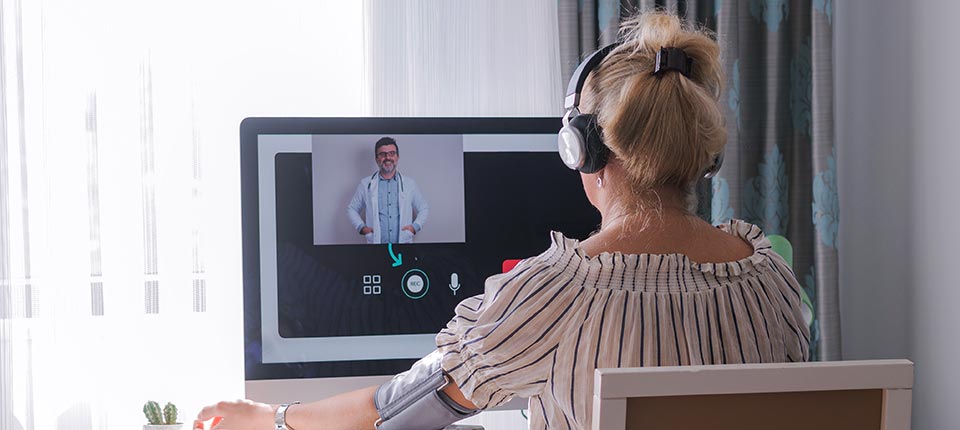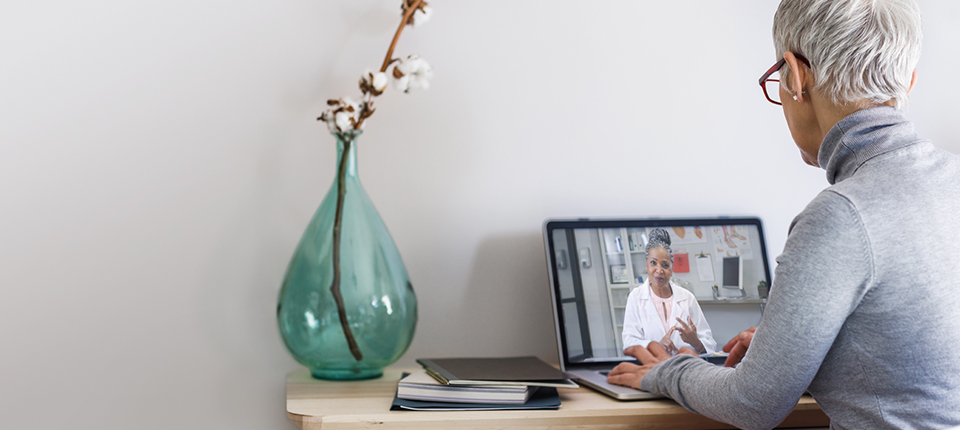
Heart matters: Remote monitoring for your heart
National survey of 285 doctors shows importance of improved virtual care, especially during the COVID-19 pandemic.
Dec. 02, 2020
- Copy Link
- Share on X
- Share on Facebook
- Share on Linkedin
For a great many things in life, the COVID-19 pandemic has led to a procrastinationwide epidemic.
With spring turning to summer turning to fall, social distancing and economic uncertainty have also served to keep us farther from the end of our to-do lists. Eventually, that bald tire is going to go flat. That old roof will spring a leak. And that aching tooth will get to be unbearable.
And what once seemed elective becomes an undeniable necessity.
Understanding though they may be, it's not just your mechanic and your dentist who wonder what took you so long. For people living with complex heart conditions, our HEART MATTERS national survey of 285 U.S. cardiologists, specialists and generalists shows a growing concern that the specter of coronavirus could be just as dangerous as the virus itself when it keeps people from seeking out the help they need.
That's where remote monitoring comes in. It's a requirement that has long driven many of our innovations, from diabetes care to cardiovascular care, including and especially during the COVID-19 pandemic, where we’re working to make remote care "just like meeting in the office" for people living with chronic conditions like diabetes, Parkinson's and heart arrythmias.
As COVID-19 Cases Grow, So Does Concern
The survey, conducted from August to September, took practicing providers' sentiment during a time when there was reason to suspect COVID-19's grip on the nation might be loosening.
In July the Centers for Disease Control and Prevention (CDC) recorded its largest single-day of new COVID-19 cases in the U.S. at 74,861. August opened comparatively lower with just 58,970 new cases. The downward trend continued into the next month, dipping to a low of 23,418 positive tests reported on Sept. 8.
Was COVID-19, like the days on the calendar, on its way to cooling from its summer heat?
By the end of September, the miracle was clearly a mirage. The month closed with 45,342 daily cases. The "second wave" took off from there, climbing continued through October and into November, which saw the first day of 100,000-plus new daily cases on Nov. 4. By the middle of the month, the U.S. was seeing nearly double that number of daily cases, with 194,610 diagnosed on Nov. 12.
It seems likely the U.S. will see 12 million cases by the end of 2020, according to Johns Hopkins University tracking.
With these increases, it's important we don't slip back into our procrastinating ways. Our HEART MATTERS national survey shines light on the impact the pandemic has had on our medical care and what could possibly be done to improve it.
Among the findings, taken during a time of relative hope for better days ahead, responders said:
- Many had not completely caught up from COVID-19's first surge even as its second takes hold. Generally speaking, there was surprise among the providers at how unprepared their organization, the government and the public were for the pandemic. This concern is compounded by the fact that many cardiologists and other specialists are still playing "catch up" after delays in "elective procedures and managing through operational inefficiencies."
- A major concern: What could come in the aftermath of the pandemic. COVID-19's impact on the heart and the disruption of care among people living with chronic cardiovascular issues is not yet fully realized. With the pandemic's impact on complex care, self-management becomes more pressing with a potential spike in cases on the horizon.
- Telehealth is helping close the gap but needs to improve. While virtual care has grown exponentially, integrating improved technology with remote treatment and monitoring will need to be met by insurers and people with the same enthusiasm before doctors will feel confident championing remote care as an option on equal footing to traditional care. And the demand is there with 79% of cardiologists interested in expanded remote monitoring and 75% of providers say their organization will encourage people with complex conditions, such as heart failure, to use remote care as much as possible.
- Doctors urge patients to seek care as needed, even as COVID-19 spikes around the country. Coronavirus is not the only illness. A majority of providers surveyed (78%) revealed they're concerned that we have yet to see the full extent of COVID-19’s impact on cardiac health and outcomes. In fact, over half (55%) of the cardiologists surveyed believe heart failure will develop at an increasing rate, most notably among those with pre-existing conditions (obesity, diabetes and high blood pressure) and adults 65+. This includes populations that experience health disparities, which technology could vastly help if made accessible. While they’re trying to embrace the upheaval and "roll with the punches," there is real fear about patients getting left behind as COVID-19 cases climb.
While the full results are striking, a few in particular stand out.
COVID-19: The Impact on Pre-Existing Conditions
As the nation prepares for December’s traditional gatherings, nearly two out of three cardiologists are concerned about patients’ ability to access cardiovascular care due to the global pandemic.
What's more, three in four cardiologists are worried that the pandemic has restricted the ability of the 6 million people living with heart failure to manage their condition. In turn — like all those miles on that worn out tire — the lack of attention could accelerate the progression of their disease. And with 89% of cardiologists reporting they’ve delayed or restricted elective procedures — including 19% explicitly for transplants — their ability to provide necessary care to deal with complications is limited.
This puts a critical importance on interdisciplinary clinical collaboration exactly when interactions among people and their care providers are greatly restricted. Safety concerns have expanded lead times to refer or transfer care.
That's creating lingering apprehension over whether virtual evaluations will meet the efficacy of in-person examinations.
But there's good news. Those surveyed said the pandemic's circumstances will ultimately strengthen communication and professional camaraderie among providers. That's good for all involved.
Remote Monitoring and Treatment: Prominent Now — And Will Only Get Bigger
While COVID-19 has necessitated more remote monitoring, those surveyed want remote monitoring to be able to do more.
For example, just over half (51%) indicated a strong desire to be able to remotely administer treatment or otherwise intervene when needed. And 40% want an expansion of real-time, 24/7 monitoring over biometrics to help predict when such intervention may be necessary.
As with any new technology, there are expected to be some growing pains.
Generalists and other specialists may be able to take their cues from their colleagues in cardiology, which has seen greater adoption of remote monitoring over the past few decades. Among those surveyed, 58% of cardiologists had direct experience using remote monitoring devices.
Given their experience, cardiologists were also significantly more likely to identify remote monitoring improvements for next generation products, such as comfort/convenience (35%), improved accuracy/precision (33%), increased integration with apps (29%) and anomaly detection/alerting (25%).
The majority of cardiologists said achieving those improvements would improve overall outcomes through early detection/mitigation (67% & 68%).
And it's not just good news for doctors.
Remote monitoring can empower patients to be more involved in managing their care (58%) — a key concern among cardiologists coming out of the pandemic — as well as reduce the demand for required in-person care (47%) and reduce the risk of hospitalization or emergency care (65%).
It makes for an enticing scenario - protecting heart failure patients from potential COVID-19 exposure while helping cardiologists give each person the best care they can.
No Person Left Behind
It's hard to calculate the full cost of COVID-19.
The survey revealed the physical, mental and economic tolls seen during the pandemic on people in their care and the potential for furthering disparities that exists in our current healthcare model.
Nearly two-thirds of cardiologists say they are concerned about people's ability to access cardiovascular care when needed, especially populations that have traditionally faced health inequities - low income, the elderly and people of color. In particular, a quarter of cardiologists are very concerned Black populations could experience increased rates of heart failure as a direct result of COVID-19.
And while virtual visits can help, hurdles remain.
Nearly two-thirds of cardiologists would also like to see remote care technology expand — especially among those with weaker access to Internet such as low-income or rural populations — and 61% would also like to incorporate simplified user interfaces to welcome less tech-savvy populations.
Overall, providers see themselves as one part of the equation: 2-in-5 cardiologists believe addressing disparities falls to insurers. Specifically, 59% of cardiologists see coverage and cost as barriers to greater adoption of remote monitoring technology.
So, in the age of COVID-19, it's not just about hesitation in leaving the house. It's also hesitation in seeing remote monitoring as a real solution for doctors and those in their care.
When remote monitoring is as commonplace as the remote control, what was once elective won't have to wait until it becomes a necessity. You can take care of it now — and with confidence.
Related articles
-
Products and Innovation
"Just Like Meeting in the Office": This is Telehealth.
For people living with chronic conditions during COVID-19, telehealth can bridge to their doctors.
For the latest on Abbott’s life-changing technology, get updates directly in your inbox.
